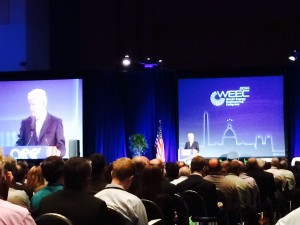It’s All About the Funding: Everything You Need To Know About Bill Clinton’s Keynote Speech at WEEC ‘14
Regardless of your feelings on politics, anyone who has ever listened to Bill Clinton speak knows he is a pretty convincing guy. In trying to unite both sides of a conflict, few orators are as gifted as Clinton at leveraging common sense to bridge a gap and bring people to the middle towards resolution of an issue; today was no different.
Clinton’s role as keynote speaker was to discuss his feeling on the world’s energy, the strategies behind renewables and how to reduce our collective carbon footprint. Clinton’s message was simple; we are on the verge of an energy breakthrough, but we have a 100 year old financial system and a 21st century energy plan that do not mix.
Let me explain- the two low hanging fruits where Clinton focused were building retrofits and renewable energy (solar, wind, etc.). These two greenhouse reduction strategies have similarities; they both create jobs, reduce consumption and typically have a 4-6 year payback. One such example of the potential efficiency improvements found in building retrofits is the recent renovation of the Empire State Building in New York City. The upgrade of the iconic New York City skyscraper was performed by Johnson Controls (yes, they used Setra sensors on the job), who through infrastructure improvements was able to reduce the building’s energy consumption by roughly 40%, and create over 300 jobs and payback the investment in less than four years. When you take into account that buildings consume over 40% of all of the energy consumed in the United States, why wouldn’t improving building efficiency be a bigger part of our energy strategy?
Just do the math: If 25% of existing buildings in the United States will be retrofitted over the next 10 years and each building averaged a 20% reduction in consumption, we would be able to reduce national consumption by 10% all the while booting the economy by providing more middle class jobs; a promise that the current administration repeated but has yet to deliver.
In the case of renewable energy, specifically wind and solar, we have seen similar success yet public sentiment seems to still be weary of it. Earlier this summer, Germany set a record when almost 75% of the energy they consumed was from renewables. During this period, the cost for electricity actually became negative! If any of you have been to Germany, the wind and the sun are not abundant, yet they are committed to an energy transformation where by the year 2020, 80% of the energy they consume is sourced by renewables. A global increase in renewables would not only provide electricity to areas where power has been typically unreliable, but also could empower the citizens in nations where the world’s dependence on crude oil finances the national governments.
So why haven’t we made it a priority to retrofit more buildings and invest in renewable energy infrastructure? The answer is that the financial system has not made it easy to secure funding for these projects. While financial institutions will happily give 20 and 30 years for power plants to payback their loans, these financial institutions do not see the same value in smaller investments with quicker payback. These are not the only solutions, they are just two low hanging fruits which should be part of a more comprehensive energy policy to diversify our sources of energy and become smarter about who we consume it.



